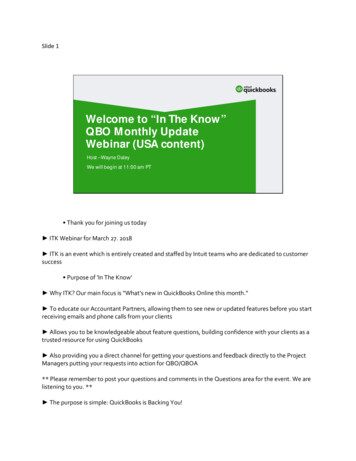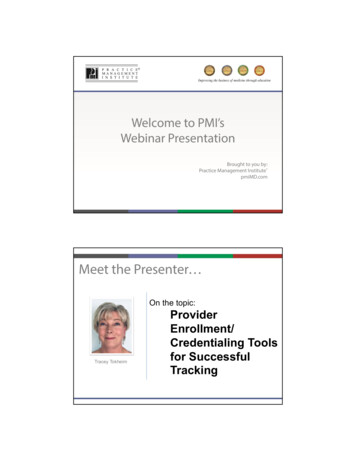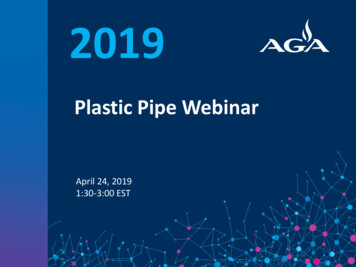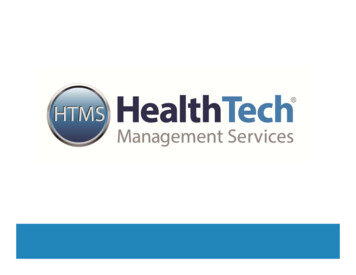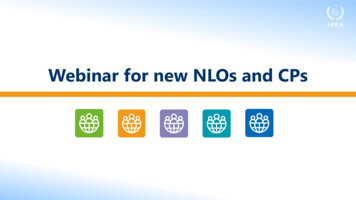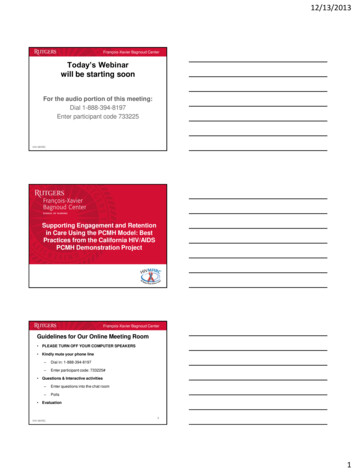
Transcription
Welcome to the 5GAA webinarPredictive QoS:A Key Technology for the AutomotiveIndustryLearn more at WWW.5GAA.ORG1
5GAA bridges the automotive and telecommunication industriesin order to address society’s connected mobility and road safety needswith applications such as automated driving, ubiquitous access to services, integrationinto intelligent transportation and traffic managementAUTOMOTIVE INDUSTRYTELECOMMUNICATIONSVehicle Platform, Hardwareand Software SolutionsConnectivity and NetworkingSystems, Devices and Technologies5GAA unites today 134 members from around the world working together on allaspects of C-V2X including technology, standards, spectrum, policy, regulations,testing, security, business models and go-to-market2
5GAA Members**as of March 20203
5GAA Priority AreasTrustImplement state-of-the-art securityand privacy by design in the V2XecosystemDigital RoadsEngage with road operators tofully integrate the road infrastructureMobile NetworksBuild upon cellular networkdeployments to fast track newmobility servicesVulnerable Road UsersEnable smart devices to deliver servicesprotecting pedestrians, cyclists, Precise PositioningConnected mobility for people, vehicles andtransport infrastructureFlexible Service ArchitecturesFoster advanced positioningsolutions for all road usersInteroperable EcosystemLeverage distributed cloud and edgecomputing capabilitiesSustained Technology EvolutionSatisfy business needs for interoperationbetween devices and services across ecosystempartnersAccelerate evolution of cellular technologies towards 5G V2X4
5GAA Organisational StructureBOARDGENERAL ASSEMBLYEXECUTIVE COMMITTEEWG1WG2WG3WG4WG5WG6WG7Use Cases andTechnicalRequirementsSystemArchitecture andSolutionDevelopmentEvaluation,Testbeds and PilotsStandards andSpectrumBusiness Modelsand Go-To-MarketStrategiesRegulatory andPublic AffairsSecurity andPrivacy5
Predictive QoS:Using 5G Network Data Analytics to enable ProactiveC-V2X Application AdaptationAli Hamidian, R&D Manager, Huawei Sweden5GAA Webinar, 26 March 2020Authors: Antonio Consoli, Mats Eriksson, Andrey Krendzel, Ali Hamidian 2020 5GAA6
Content1Which problem is Predictive QoS addressing?2What is Predictive QoS?3How can automotive applications make use of it?4Has it been implemented?5What is the status in terms of standardization?7
Which problem is Predictive QoS addressing?A real need formulated by vertical industriesA real need from verticals,Mission-criticalnot a telecomapplicationspushrely on their QoSrequirements being met, since application failure orsuspended operation can have a high cost.Source: VolkswagenHowever, the “network may not be able to alwaysguarantee the required QoS of the service.” (*)Therefore, mission-critical applications may need to adaptto QoS changes. This adapation should complete before apotential QoS change.Source: ABB(*) 3GPP TS 22.261, Section 6.238
What is Predictive QoS?Predictive QoS: A feature thatallows the mobile network toprovide notifications aboutpredicted QoS changes toenable in-advance adjustmentof the application behaviour.Application receives in-Advance QoSNotification (IQN) of potentialnetwork quality degradation2”QoS is estimated to drop inx seconds and degradationmay last for y seconds”Tele-Operating driverIQN5G4Network QoS degradationtakes effect. Necessary actionhas already been taken.5Network QoS is back to normalKm/h30 km/hVehicle speed: 50Example of QoS parameters for ToD service:3Application takes appropriate action/countermeasure(e.g. decrease speed, change lane)1Connected vehicleis being driven throughtele-operationApplication 5QIclassVideo and 2audio5QI featuresResource type: GBRPDB: 150 msPER: 10-3116MbpsNote:UL GFBR: 11660 MbpsMbpsPredictedQoSQoS changechangeVehicletwo transmission83Resource type:Delay Critical GBRC-V2X definesmodes:commandPDB: 10 ms long-range communicationsPER: 10-4 via the mobileStatus4 interfaceResource type: GBRnetwork,using UuinformationPDB: 300 ms direct short-range communications,usingPER: 10-6UL GFBR:as4 MbpsPC5 interface, also known“sidelink”Conversatio1 onResourcetype: GBRThis webinarfocusesUu-basedlong-rangenal voicePDB: 100 mscommunications via thePER:mobilenetwork.10-29
Three main steps of Predictive QoS1. Collect Data(required to supportprediction)2. Analyze andMake Prediction(using ML or othertechnologies)3. DeliverPredictionVehicle (location, planned route, speed, performance measurements, detectedhazardous road conditions, situational awareness)Road infrastructure (road topology, traffic signs, road traffic)Network (network load, resources, O&M measurements)Weather (rainfall, visibility due to fog, wind speed)Coverage (e.g. coverage maps with performance measurements)Large events (sports, concerts, festivals)Analytics (handover failure rate, statistics)10
Examples of Use Cases and Application ReactionsUse CasesQoS KPIs tobe PredictedExamples of PotentialApplication ReactionsHigh-DensityPlatooninglatency, reliability,coveragechange inter-vehicle distance, handover to driver,change platoon speed or length, terminate platoonTele-OperatedDrivingdata rate, latency, change route, change ToD mode (e.g. frommaneuvering to trajectory provisioning), handover toreliability, coverageLane MergeAssistlatency, reliability,coveragechange speed of merging attempt, abort lane mergeInfotainmentdata rate,coveragechange video qualitySoftwareUpdatedata ratereschedule, stop or resume downloadHazardous LocationWarningreliability,coveragechange driving properties, detournearby driver, change sensor properties, park vehicle11
Live Demo by DT Predicted QoS ontwo road segmentsbetween Munichand Ingolstadt atMonday 5:00 PMSource: DT12
Poll Question: When would you expect Predictive QoS to be widely available in mobilenetworks to further enable advanced driving services? Answer alternatives: Before 20252025-2030After 2030Never13
Predictive QoS is Widely Recognized in the Industry NESQO (Predictable QoS and End-to-end Network Slicing for Automotive Use Cases) defined the requirements and the architectural enhancementsneeded to support Predictive QoS in the 3GPP System, addressing both MNO-based and OTT-based predictions. eNESQO (Enhanced E2E Network Slicing and Predictive QoS) brings forward the results of previous WI NESQO, e.g., in the areas of Making Predictions,Prediction Function Location, Application and Network Reaction to QoS Prediction and proposes 6 areas of improvement for current 5G solution MEC4AUTO (Multi-access Edge Computing Technology for Automotive Services) studies the use of MEC in multi-MNO and multi-OEM scenarios. The WIevaluates support for In-advance QoS Notification (IQN) management in multi-operator scenarios, including a potential definition of a NESQO-Edge API. ADAPT (In-advance/Predicted QoS Notification for 5G) investigates usage of Predictive QoS for Industrial Automation. SA1: TS 22.186 “Enhancement of 3GPP support for V2X scenarios” (Release 16) received 5GAA NESQO requirements on Predictive QoS SA2: TS 23.288 “Architecture enhancements for 5G System (5GS) to support network data analytics services” (Release 16) defines the QoS SustainabilityAnalytics that includes QoS predictions. QoS-related prediction analytics also introduced in the context of other key issues. SA2: TS 23.287 “Architecture enhancements for 5G System (5GS) to support Vehicle-to-Everything (V2X) services” (Release 16) includes procedure for V2XApplication adjustment based on the QoS sustainability analytics. SA2: TR 23.700 “Enablers for Network Automation for 5G – phase 2)” includes a key issue “NWDA-assisted predictable network performance” whichaddresses Predictive QoS topics. SA6: TR 23.764 “Study on enhancements to application layer support for V2X services” (Release 17) includes a key issue (2a) about exposing potential QoSchange procedure in TS 23.287 to dynamically provide/adapt the service operation and related QoS requirements for single or groups of UEs. ETSI ISG MEC (Multi-Access Edge Computing) has studied Predictive QoS for V2X as part of the completed study item on MEC support for V2X usecases, captured in the ETSI GR MEC 022 V2.1.1. The resulting normative work on V2X Information Service API is ongoing and being documented in theETSI GS MEC 030. GSMA Generic Slice Template (GST) NG.116 V2.0 included performance prediction as one attribute for the capability of the mobile system to predict thenetwork and service status. 5G-PPP 5GCroCo (5G Cross-Border Control) within EU research program H2020 has the objective to test and validate advanced 5G features, includingPredictive QoS.14
Key Take-Away MessagesPredictive QoS 1. allows applications to prepare for varying network conditions well ahead2. is a real need, a requirement formulated by 5GAA Automotive Industry 3. is now widely recognized in the industry and work is ongoing in major standards organizationsand industry associations 4.VW, Daimler, BMW, etc.5GAA, 3GPP, 5G-ACIA, ETSI, 5GCroCo, 5G NetMobil, GSMA, etc. has basic foundation in place in 3GPP Rel-16 but key challenges remain Some gaps are identified for existing solution to evolve in Rel-17 and later.5GAA is driving forward Predictive QoS together with key organizations such as 3GPP, ETSI, 5G-ACIA and5G-PPP as a good example of cross-industry collaboration.Companies contributing to 5GAA Predictive QoS work items.15
Download the 5GAA White Paper toknow more about Predictive omotive-industry/ 2019 5GAA16
Thank You!Follow 5GAA:Twitter: @5GAA officialLinkedIn: 5G Automotive AssociationContact us: marcom@5gaa.org 2020 5GAA17
takes effect. Necessary action has already been taken. 4 Application takes appropriate action/countermeasure (e.g. decrease speed, change lane) 3 5G 2 Application receives in-Advance QoS Notification (IQN) of potential network quality degradation 5 Network QoS is back to normal Predictive
